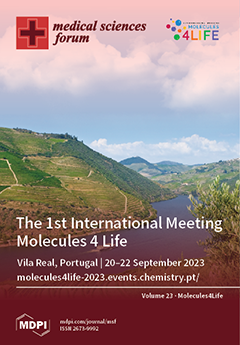Med. Sci. Forum, 2023, Molecules4Life
The 1st International Meeting Molecules 4 Life
Vila Real, Portugal | 20–22 September 2023
Volume Editors:
Miguel Ribeiro, Chemistry Research Centre-Vila Real (CQ-VR), Portugal
Fernanda Cosme, Chemistry Research Centre-Vila Real (CQ-VR), Portugal
Lucinda V. Reis, Chemistry Research Centre-Vila Real (CQ-VR), Portugal
Paula Lopes, Chemistry Research Centre-Vila Real (CQ-VR), Portugal
Rui Campos, International Iberian Nanotechnology Laboratory (INL), Portugal
Alice Vilela, Chemistry Research Centre-Vila Real (CQ-VR), Portugal
- Issues are regarded as officially published after their release is announced to the table of contents alert mailing list.
- You may sign up for e-mail alerts to receive table of contents of newly released issues.
- PDF is the official format for papers published in both, html and pdf forms. To view the papers in pdf format, click on the "PDF Full-text" link, and use the free Adobe Reader to open them.



